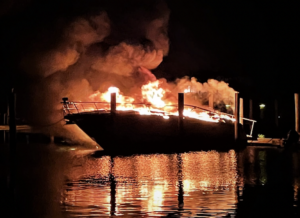Volvo Penta expands IMO Tier III range
 IMO-tier-III-range-expands-with-new-D13-solutions-01
IMO-tier-III-range-expands-with-new-D13-solutions-01
Volvo Penta has expanded its marine IMO Tier III range with new D13 solutions. The latest launch expands the range of marine commercial Volvo Penta D13 IMO III solutions for IPS-1200, IPS-1350, D13-900, and D13-1000. The company says each package exceeds the IMO III standards and also offers customers the most compact IMO III solution on the market.
According to Volvo Penta, the D13 IMO III package upgrade boasts a power output of up to 735kW for inboard and auxiliary applications and is approved for E3 and C1 cycles. The reduction in NOx and hydrocarbon (HC) will decrease from currently permitted levels of 5.6 g/kWh down to 2.0 g/kWh.
The selective catalytic reduction (SCR) system can be installed in either a vertical or horizontal position, thanks to the new rotating outlet.
Volvo Penta and Norwegian shipyard Måløy Verft have delivered the first installation of the new Volvo Penta D13-1000 IMO III package: the new Norwegian ambulance boat Rosesol is a 23-metre high-speed fiberglass catamaran with an 8-metre beam, powered by twin Volvo Penta D13-1000 IMO III. Rosesol is capable of speeds of more than 30 knots. The new vessel launched in May 2022 and now services an area on the country’s west coast spanning 100 nautical miles and more than 200 islands.

“In this region it’s necessary to have an ambulance boat because it’s not possible to go to the hospital by car,” says Kjell Augestad-Mjåtvedt, captain of the Rosesol. “This vessel’s impressive speed and fuel efficiency are important because of the distances we cover – time is critical for many patients.
“The most important performance for an ambulance vessel like this is to be able to maintain high speed in tough conditions. We now have the capability of 30-plus knots, not only on flat seas but also in gales and rough water,” says Augestad-Mjåtvedt.
Kristian Lundebrekke, CEO of the shipyard Måløy Verft, comments: “What is special about this ambulance vessel starts with the high demands set by the Norwegian government. We need to meet tough sea conditions, we need to be operative every day of the year – reliable – and we need to be environmentally friendly.
“Volvo Penta delivers a complete package for what we need. The complete engines include the SCR unit, which makes for an easy install, it is all easy to use and understand, and they deliver low weight and stable power output. These are all important factors for us.”
The new Volvo Penta D13 IMO III package upgrade follows the earlier releases of the Volvo Penta D13 offer for marine commercial, D8, and D16 solutions that also meet the stringent IMO III requirements.
“Our primary focus remains on innovating tomorrow’s premium sustainable marine propulsion solutions, plus we are equally responsible for advancing today’s best practice,” says Johan Inden, president of the Volvo Penta Marine business. “So, in parallel to developing future hybrid and alternative fuel solutions, the new D13 IMO III solutions demonstrate our commitment to continually improving the efficiency and performance of every Volvo Penta product.”
The compact design of the Volvo Penta IMO Tier III solution means that existing Volvo Penta IPS-powered vessels will be able to fit the system without engine room alterations.
Volvo Penta supplies a fully integrated system that is designed, developed, and manufactured by one company. The company also says the Volvo Penta SCR system does not require service, as it has the same life span as the engine it is coupled with.
Volvo Penta says it has been able to fulfill IMO III targets while reducing fuel consumption – despite the SCR adding exhaust backpressure, the engine power output remains unchanged.
“We have gained a lot of experience during the years of designing after-treatment systems within the Volvo Group and for our industrial and marine commercial offerings,” says Björn Rönnvall, product manager, Volvo Penta. “This has enabled us to finetune the solution – extending its lifespan, maintaining, and even bettering, its fuel consumption – and delivering all this in a compact, flexible package. Ultimately, we want to make this transition as simple as possible for our customers – supporting them and the ocean environment we all love.”










